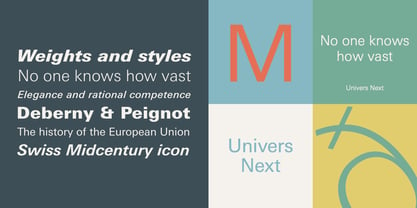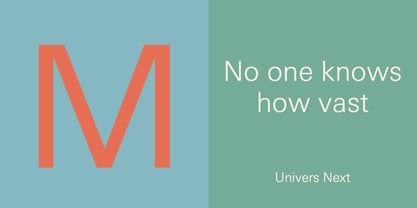Univers Next Pro 130 Basic Ultra Light
Univers Next Pro 131 Basic Ultra Light Italic
Univers Next Pro 230 Basic Thin
Univers Next Pro 231 Basic Thin Italic
Univers Next Pro 330 Basic Light
Univers Next Pro 331 Basic Light Italic
Univers Next Pro 430 Basic Regular
Univers Next Pro 431 Basic Italic
Univers Next Pro 530 Basic Medium
Univers Next Pro 531 Basic Medium Italic
Univers Next Pro 630 Basic Bold
Univers Next Pro 631 Basic Bold Italic
Univers Next Pro 730 Basic Heavy
Univers Next Pro 731 Basic Heavy Italic
Univers Next Pro 830 Basic Black
Univers Next Pro 831 Basic Black Italic
Univers Next Pro 930 Basic Extra Black
Univers Next Pro 931 Basic Extra Black Italic
Univers Next Pro 120 Condensed Ultra Light
Univers Next Pro 121 Condensed Ultra Light Italic
Univers Next Pro 220 Condensed Thin
Univers Next Pro 221 Condensed Thin Italic
Univers Next Pro 320 Condensed Light
Univers Next Pro 321 Condensed Light Italic
Univers Next Pro 420 Condensed Regular
Univers Next Pro 421 Condensed Italic
Univers Next Pro 520 Condensed Medium
Univers Next Pro 521 Condensed Medium Italic
Univers Next Pro 620 Condensed Bold
Univers Next Pro 621 Condensed Bold Italic
Univers Next Pro 720 Condensed Heavy
Univers Next Pro 721 Condensed Heavy Italic
Univers Next Pro 820 Condensed Black
Univers Next Pro 821 Condensed Black Italic
Univers Next Pro 921 Condensed Extra Black Italic
Univers Next Pro 110 Compressed Ultra Light
Univers Next Pro 210 Compressed Thin
Univers Next Pro 310 Compressed Light
Univers Next Pro 410 Compressed
Univers Next Pro 510 Compressed Medium
Univers Next Pro 140 Extended Ultra Light
Univers Next Pro 141 Extended Ultra Light Italic
Univers Next Pro 240 Extended Thin
Univers Next Pro 241 Extended Thin Italic
Univers Next Pro 340 Extended Light
Univers Next Pro 341 Extended Light Italic
Univers Next Pro 440 Extended Regular
Univers Next Pro 441 Extended Regular Italic
Univers Next Pro 540 Extended Medium
Univers Next Pro 541 Extended Medium Italic
Univers Next Pro 640 Extended Bold
Univers Next Pro 641 Extended Bold Italic
Univers Next Pro 740 Extended Heavy
Univers Next Pro 741 Extended Heavy Italic
Univers Next Pro 841 Extended Black Italic
Univers Next Pro 840 Extended Black
Univers Next Pro 940 Extended Extra Black
Univers Next Pro 941 Extended Extra Black Italic
Univers Next Pro 430 Typewriter Regular
Univers Next Pro 431 Typewriter Italic
Univers Next Pro 630 Typewriter Bold
Univers Next Pro 631 Typewriter Bold Italic
Univers Next Pro 920 Condensed Extra Black



